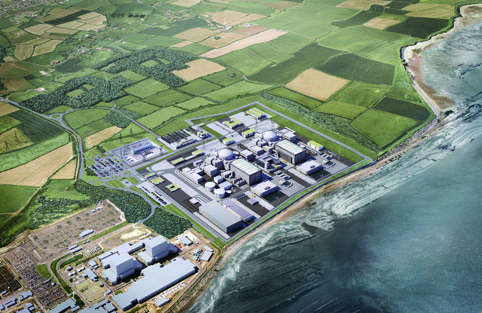Realising that future revenue streams for electricity from new nuclear stations are crucial for developers to make final investment decisions, the UK government introduced a draft bill to Parliament in 2012 that proposed a restructuring of pricing for electricity in the electricity market. This bill, known as Electricity Market Reform (EMR) is due to achieve Royal Assent later in 2013. Key to this reform is the agreement of a Contract for Differences (CfD) whereby the price of electricity is fixed at a ‘strike price’.
In simple terms, utility companies will pay back any excess of the market price over strike price and likewise, receive a payment when market price is below strike price. There are two big advantages to this mechanism. First, the strike price can be fixed for a long period, giving a high degree of certainty for return on investment. Second, consumers can benefit from a stable price of electricity.
However, this certainty and predictability itself comes at a price, and on Monday 21 October 2013 the price deal between EDF and HMG for EDF projects at Hinkley Point and Sizewell was announced at £89.50 per megawatt hour, rising to £92.50 if the Sizewell scheme does not go forward. This price will apply when the new stations start generation early in the 2020s. The current wholesale price for electricity is around £45 per megawatt hour.

How is such a price justified? Proponents will claim that ever increasing demand for ‘greener’ electricity has to be met by a significant baseload generation technology and that nuclear power is the obvious choice. High capital costs are offset by significantly lower costs for operation through the 60-year life of the stations, however the investment risk has to be paid for and this is reflected in the price needed to attract that investment. Opponents will say that uncertainties over ultimate waste disposal from the stations and decommissioning costs add an unacceptable cost burden to the consumer and that greater emphasis should be placed on other forms of renewable energy.
Ultimately, the domestic, industrial and commercial sectors of our economy demand electricity at the press of a button irrespective of whether the sun shines or the wind blows, and given that more than 40 per cent of the UK electricity generating capacity is currently met by coal-fired power stations, we will need to take tough decisions if we want to move to a low-carbon economy, stabilise electricity prices and secure our own supply of energy for the UK.
So, EDF will move forward to a final investment decision at Hinkley Point, Horizon needs Hitachi to take its Advanced Boiling Water Reactor (ABWR) through the GDA process, which could take four years, and NuGen will need to decide on which technology it will deploy at Moorside (Sellafield) before it can even apply for planning permission. All of this means that we will not see a new nuclear power station generating electricity in the UK until sometime in the 2020s. And who will actually construct these stations? Commitments are being made by the developers to support UK manufacturers. However, to what extent? Outside of civil construction, where will the high-value components and fabrications be made?
New nuclear reactor technology for the UK is likely to be French, US or Japanese and so how much of these big infrastructure schemes will truly be ‘Made in Britain’? Well, the Nuclear AMRC will sit at the heart of supply-chain development for the UK civil nuclear industry. Its mission is to help UK manufacturers win work and it will do this through a ‘Sharing in Growth’ programme that will help UK manufacturers increase their competence, capability and cost effectiveness to secure lucrative contracts at home and abroad; and an innovative advanced manufacturing R&D programme at its 8,000m2 state-of-the-art facility on the Advanced Manufacturing Park. With a total investment of £68m over five years, the Nuclear AMRC is destined to play an exciting role in a new era of civil nuclear power for the UK.





April 1886: the Brunkebergs tunnel
First ever example of a ground source heat pump?